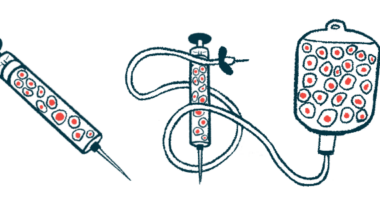BEAM-101 gene-editing stem cell therapy shows promise in SCD
Early signs of efficacy seen in severe disease patients in Phase 1/2 trial

In a Phase 1/2 clinical trial, the gene-editing stem cell therapy BEAM-101 worked as intended, and showed early signs of efficacy in people with severe sickle cell disease (SCD), according to new early data.
Developer Beam Therapeutics will present the findings at the upcoming American Society of Hematology (ASH) Annual Meeting and Exposition, to be held Dec. 7-10 in San Diego.
Normally, stem cell therapies require patients to undergo a round of chemotherapy before treatment, but this can be very toxic. Beam will also present preclinical findings on a less toxic alternative to chemotherapy that it’s been working on, the company said in a press release.
“For people living with severe sickle cell disease, … stem cell transplant with genotoxic [DNA-damaging] chemotherapy is the only currently available curative option. At Beam, we have a long-term commitment to delivering better treatments for these patients,” said John Evans, Beam’s CEO, adding that the company’s goal is “to eliminate chemotherapy from the transplant process altogether.”
Evans said the positive data on BEAM-101 “[represent] an important milestone toward this vision.”
Data on gene-editing stem cell therapy to be shared at December meeting
Hemoglobin is the protein in red blood cells that’s responsible for carrying oxygen to the body’s tissues. Before birth, a version of the protein called fetal hemoglobin is produced. That’s switched off sometime after birth and the production of an adult version is switched on.
In SCD, genetic mutations give rise to a faulty version of adult hemoglobin, called hemoglobin S, that causes red blood cells to take on the abnormal sickle-like shape that gives the disease its name. That abnormal shape makes it more difficult for these cells to travel through blood vessels, leading to pain episodes known as vaso-occlusive crises, or VOCs, and other SCD symptoms.
BEAM-101 works to turn back on the production of fetal hemoglobin in patients’ blood cells, thus preventing red blood cell sickling and easing SCD symptoms. It specifically modifies a region of the HBG1/2 genes, which encode the production of a part of fetal hemoglobin.
The therapy employs a gene-editing approach called base editing, which modifies specific DNA building blocks without creating cuts in the DNA. This approach, according to Evans, is believed to lead to “more precise and efficient editing” than is seen with other gene-editing strategies.
The treatment involves collecting an individual’s hematopoietic stem cells — HSCs, or blood cell precursors — and editing them in the lab. The edited cells are then returned to the patient via an infusion into the bloodstream. They’re then expected to make their way to the bone marrow and engraft, or begin giving rise to new blood cells, that produce fetal hemoglobin.
Before receiving a BEAM-101 infusion, a patient must first complete a round of chemotherapy with an agent called busulfan. Known as a conditioning regimen, this clears out existing HSCs and makes room for the newly edited cells in the bone marrow.
The Phase 1/2 BEACON trial (NCT05456880), which started dosing earlier this year, is testing the safety and efficacy of BEAM-101 in approximately 15 people with severe SCD, ages 18-35.
The preliminary trial data to be presented at the conference will cover initial findings from six treated patients, as of the cutoff date of July 2.
Safety profile of BEAM-101 consistent with known side effects
Beam reports that the safety profile of BEAM-101 was consistent with the known side effects of busulfan and stem cell transplant.
There were no serious adverse events related to BEAM-101 itself, according to researchers. One person died four months after dosing due to respiratory failure, which was deemed by trial investigators as likely related to busulfan conditioning and is a known type of complication that can occur.
All four patients with at least one month of follow-up experienced rapid and robust increases in fetal hemoglobin, with corresponding decreases in hemoglobin S, which were sustained over time.
For these patients, markers of red blood cell destruction normalized or improved, and no VOCs were reported.
In another presentation, the researchers will discuss preliminary data related to biomarkers of red blood cell health in three trial participants.
These results indicated that nearly all red blood cells (98%-99%) expressed fetal hemoglobin as soon as one month after treatment, with a near-complete elimination of cells containing only hemoglobin S. A reduction also was seen in red blood cell sickling, along with other indicators of better red blood cell health.
Beam indicated that, at the conference, the company will present additional data from more patients and a longer follow-up time.
Along with the strong translation from preclinical to clinical of our BEAM-101 program, these data reflect the potential of base editing to enable new therapeutic possibilities for people suffering from serious diseases.
Conditioning agents like busulfan are toxic and associated with significant side effects. Beam has been working on developing a less toxic conditioning approach called ESCAPE, which bypasses chemotherapy altogether.
The company will also present preclinical data showing the safety and feasibility of this approach at the upcoming ASH conference.
“Along with the strong translation from preclinical to clinical of our BEAM-101 program, these data reflect the potential of base editing to enable new therapeutic possibilities for people suffering from serious diseases,” said Giuseppe Ciaramella, PhD, president of Beam.








